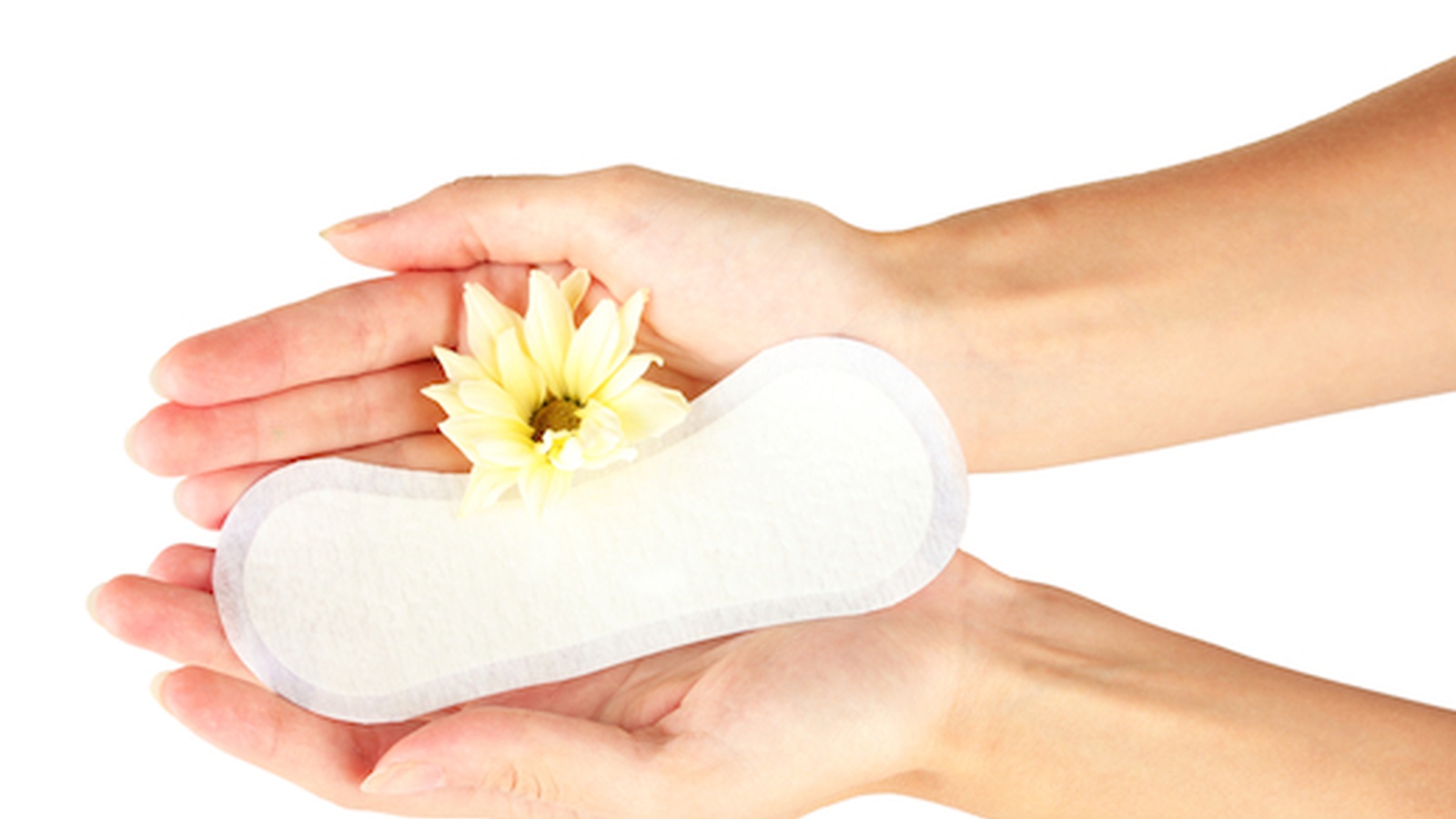Are Feminine Hygiene Products Slowly Harming You? (Plus Safe Alternatives)
The issue of safe feminine hygiene product options is rarely discussed, but it’s an important topic for roughly a third of the population.
Why? Your skin is the largest organ in your body, and also the thinnest. Less than one-tenth of an inch separates your body from potential toxins. Worse yet, your skin is highly permeable — especially the skin in and around the vaginal area.
Anything coming in constant contact with your skin will land in your bloodstream for distribution throughout your body. This is why I’m so fond of saying:
“Don’t put anything on your body that you wouldn’t eat if you had to.”
Chemicals on your skin may be worse than eating them. At least enzymes in your saliva and stomach help break down and flush chemicals from your body. But when they touch your skin, they’re absorbed straight into your bloodstream, going directly to your delicate organs. Once in your body, they can accumulate because you typically lack the necessary enzymes to break them down.
In my opinion, feminine hygiene products can be likened to a “ticking time bomb” due to years of exposure. The average American woman uses 16,800 tampons in her lifetime — or up to 24,360 if she’s on estrogen replacement therapy.
And that’s just tampons. Many women use different types of sanitary pads, alone or with tampons, and there’s also nursing pads.
What's Really in Those Sanitary Pads and Tampons?
In the featured article, Andrea Donsky, founder of Naturally Savvy and co-author of Label Lessons: Your Guide to a Healthy Shopping Cart, reveals how little we’re told about the materials in feminine products. In fact, tampon and sanitary pad manufacturers aren’t required to disclose ingredients because feminine hygiene products are considered “medical devices.”
 When Andrea called Procter & Gamble directly to discover the contents in their Always Infinity pads, the service reps could only mention two: foam and a patented ingredient called Infinicel — a highly absorbent material able to hold up to 10 times its weight.
When Andrea called Procter & Gamble directly to discover the contents in their Always Infinity pads, the service reps could only mention two: foam and a patented ingredient called Infinicel — a highly absorbent material able to hold up to 10 times its weight.
In fact, conventional sanitary pads can contain the equivalent of about four plastic bags! With everything we now know about the hazardous nature of plastic chemicals, this alone is cause for concern.
For example, plasticizing chemicals like BPA and BPS disrupt embryonic development. They’re linked to heart disease and cancer. Phthalates, which give paper tampon applicators a smooth finish, are known to dysregulate gene expression, and DEHP may lead to multiple organ damage. Synthetics and plastic restrict air flow and trap heat and dampness, potentially promoting yeast and bacteria growth in your vaginal area. Besides crude oil plastics, conventional sanitary pads can also contain other potentially hazardous ingredients, such as odor neutralizers and fragrances.
The Price You Pay For 'Clean' White Tampons And Pads
How do tampons and pads get that ultra-white “clean” look? Usually chlorine bleach, which can create toxic dioxin and other disinfection-by-products (DBPs) such as trihalomethane. Studies show dioxin collects in your fatty tissues. According to an EPA draft report, dioxin is a serious public health threat that has no “safe” level of exposure! Published reports show that even trace dioxin levels may be linked to:
- Abnormal tissue growth in the abdomen and reproductive organs
- Abnormal cell growth throughout the body
- Immune system suppression
- Hormonal and endocrine system disruption
Meanwhile, the FDA’s official stance is that no expected health risks are associated with trace amounts of dioxins in tampons.
Naturally Savvy notes that 10 years ago, House Representative Carolyn Maloney introduced legislation requiring research into the potential health risks of feminine hygiene product use, including cervical, ovary and breast cancers and endometriosis. Unfortunately, the legislation failed to pass, and it doesn’t appear there’s been any research.
Could You Be Absorbing GMOs Via Your Tampons?
Numerous alarm bells went off for Andrea as she researched potential hazards of feminine products for her book, Label Lessons, such as:
Conventional tampons contain pesticides: A whopping $2 billion is spent annually on pesticides to spray cotton crops.
Conventional tampons probably contain genetically modified organisms (GMOs). According the USDA, 94 percent of all U.S. cotton is genetically engineered.
Tampons and pads with odor neutralizers and artificial fragrances are virtually a chemical soup, laced with artificial colors, polyester, adhesives, polyethylene (PET), polypropylene and propylene glycol (PEG), contaminants linked to hormone disruption, cancer, birth defects, dryness and infertility.
Andrea wondered whether if using a GMO tampon several times every month was any different than ingesting GMO food. But it may even be worse, considering the vaginal wall is highly permeable, allowing toxins like pesticide residue and GMO proteins direct access into the bloodstream.
Beware Of Toxic Shock Syndrome
 Remember: Tampons create a favorable environment for bacteria growth. Micro-tears in the vaginal wall from tampons allow bacteria to accumulate. One infamous risk is Toxic Shock Syndrome (TSS), caused either by poisonous toxins from Staphylococcus aureus (staph) or group A streptococcus (strep) bacteria. TSS is a life-threatening condition, so symptom recognition is crucial. Should any of the following symptoms occur during your tampon use, seek medical help immediately:
Remember: Tampons create a favorable environment for bacteria growth. Micro-tears in the vaginal wall from tampons allow bacteria to accumulate. One infamous risk is Toxic Shock Syndrome (TSS), caused either by poisonous toxins from Staphylococcus aureus (staph) or group A streptococcus (strep) bacteria. TSS is a life-threatening condition, so symptom recognition is crucial. Should any of the following symptoms occur during your tampon use, seek medical help immediately:
- Sudden high fever
- Vomiting
- Diarrhea
- Low blood pressure
- Seizures
- Rash on palms or soles of feet
- Muscle aches
- Redness of your eyes, mouth and/or throat
To Minimize Your Risk Of This Potentially Life-Threatening Condition:
- Avoid super absorbent tampons – choose the lowest absorbency rate to handle your flow
- Never leave a tampon inserted overnight; use overnight pads instead
- When inserting a tampon, be extremely careful not to scratch your vaginal lining (avoid plastic applicators)
- Alternate the use of tampons with sanitary napkins or mini-pads during your period
- Change tampons at least every 4-6 hours
- Do not use a tampon between periods
- Safer Alternatives
 Many of today’s feminine hygiene products contain rayon, vicose, and cellulose wood fluff pulp… not cotton, let alone organic cotton. Rayon and viscose present a potential danger because of their highly absorbent fibers, which can stick to your vaginal wall. Upon removal, the loosened fibers stay behind, raising your TSS risk.
Many of today’s feminine hygiene products contain rayon, vicose, and cellulose wood fluff pulp… not cotton, let alone organic cotton. Rayon and viscose present a potential danger because of their highly absorbent fibers, which can stick to your vaginal wall. Upon removal, the loosened fibers stay behind, raising your TSS risk.
Fortunately, there are safer alternatives. Since the FDA regulates tampon absorbency, all tampons on the market must meet absorption guidelines. According to Dr. Philip Tierno, a Clinical Professor of Microbiology and Pathology at NYU Medical Centre, 100% cotton tampons must “consistently test under detectable levels for TSS toxins.”
Did you know these ingredients were in your feminine hygiene products? Would you switch to natural alternatives?
Discover how to lose excess fat from your belly, face & thighs in less than 7 days with this simple ancient practice. Watch the Detox Masterclass here. Playing for a limited time!








